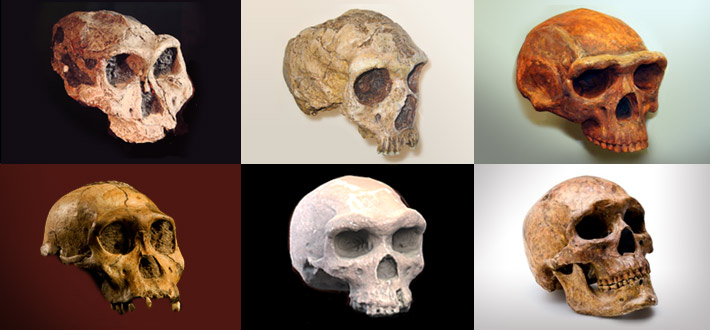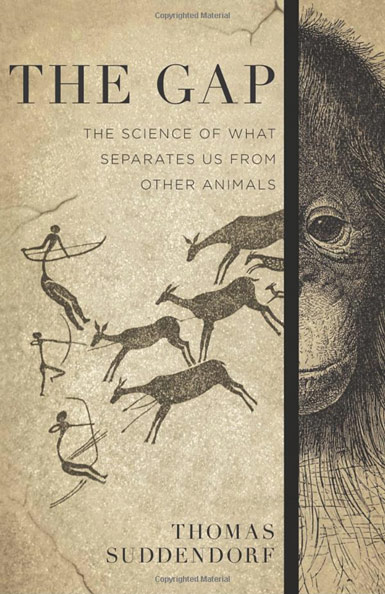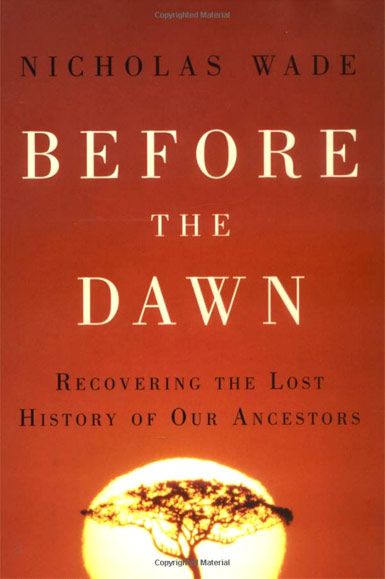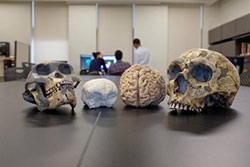
How Humans Evolved from Our Hominid Predecessors
The hominid history is constantly revised as new skeletal remains are found, but the evidence paleontologists have to work with remains sparse, consisting of few fossil bone fragments. Nevertheless, looking back as far as we can with the evidence currently available, we can better understand human evolution and our place in the world, where we differ from our hominid ancestors, and when and how these differences came about.
Chris Stringer, author of Lone Survivors: How We Came to Be the Only Humans on Earth, points out that there was no sudden evolutionary leap to fully human beings but instead a gradual evolution of human abilities. He says, “There is growing evidence that elements of modern behavior were there a hundred thousand years ago, and I think the gap or mismatch between the emergence of modern anatomy and modern behavior may well be much less significant than currently believed.” As he points out, brain organization and certain physiological features unrelated to size are more closely related to intelligence than brain size alone, and evidence shows that early forms of humans possessed some incipient cognitive abilities that were to become mature in H. sapiens.
In The Gap: The Science of What Separates Us from Other Animals, research psychologist Thomas Suddendorf concludes that our abilities in these cognitive areas far surpass those of animals because our minds evolved two overarching qualities: our drive to understand one another, and our ability to imagine different possible futures.
It is common, both in science and in everyday life, to conclude that there was always a huge difference between human beings and other primates. But this idea exists and persists only because all the other archaic humans died out thousands of years ago, leaving only us and our simian relatives, especially the great apes, chimps and bonobos.
In 1858, Charles Darwin proposed that human beings evolved from apes via natural selection. It shocked the world. After all, for more than two thousand years, our view of ourselves had been influenced by the Ancient Greeks, who glorified the human form and human accomplishments in art, philosophy and religion. Even their gods were created in the image of humans—an idea that was perpetuated in Christianity.
A decade after Darwin’s declaration in The Origin of Species, the first fossils of early modern humans were found at the 27,000- to 23,000-year-old Cro-Magnon rock shelter in southern France.
Advances in the field of genetics and insights from archeologists, anthropologists, primatologists and other specialists support Darwin’s profound insight, while new findings and modern dating methods have reshaped how we think about our evolutionary story. The old idea that saw human evolution as a straight line—an ape slowly standing taller, becoming Neanderthal, and finally evolving into modern man—we now know is entirely wrong. Evolution is better described as a tree rather than a straight line, with many branches sprouting, though only some species survived.
During the last six or seven million years at least 10, and possibly as many as 18, different hominid species lived on the earth. 6.5 million to 5 million years ago, some 100,000 apes, the ancestors of today’s apes and humans, lived in East Africa in a forest shrinking due to climate cooling. There were two kinds of survivors of this climate change, one stayed with what was left of the forest and continued as before, the other was the beginning of the human line; it survived by occupying both the trees and the new spaces in between.
According to the oldest evidence to date, Homo (human) split from Pan of the great apes, chimps and bonobos some 7-6 million years ago. But early humans were not the only hominins walking the Afar plains. Instead, several branches of the human family tree—including Australopithecus afarensis (Lucy and Selam), Ardipithecus kadabba, and Ardipithecus ramidus (“Ardi”), and early Homo species were developing at the same time, competing for resources, or perhaps finding ways to share them.
Ardipithecus kadabba were arboreal but capable of upright walking. About 4 million years ago, as climate fluctuations increased, our distant ancestor, the australopithecine, was able to survive in both wooded and grassland terrains because of this critical ability: to walk upright on two feet.
There are almost certainly other extinct Homo species that are still unknown to us and that may well cause us to rethink the beginnings of our evolution. Reanalyzing a million-year-old skull from China known as Yunxian 2 points to an Asian lineage that includes Homo longi and the Denisovans. It suggests that modern humans, Neanderthals, and Denisovans started going their separate ways far earlier than we thought. The conventional DNA-based picture says an ancestral population split into (1) modern humans and (2) a branch that later divided into Neanderthals and Denisovans. It now looks as though Neanderthals split off first, around 1.38 million years ago, with modern humans and Denisovans diverging later—the longi and sapiens diverged around 1.32 million years ago and the sapiens group itself began around 1.02 million years ago.
“This changes a lot of thinking because it suggests that by 1m years ago our ancestors had already split into distinct groups, pointing to a much earlier and more complex human evolutionary split than previously believed. It more or less doubles the time of origin of Homo sapiens,” Chris Stringer of London’s Natural History Museum, a coauthor on the new study, told The Guardian.
It pushes the split between our own ancestors, Neanderthals, and Homo longi back by at least 400,000 years. It also raises the possibility that the birthplace of our lineage wasn’t in Africa, where the oldest clearly modern human fossils date to about 300,000 years ago. Instead, the ancestor of Homo sapiens could have lived in western Asia, before later populations moved back into Africa to evolve into us. “It looks more likely that the ancestor was outside of Africa, perhaps in Western Asia,” Stringer told New Scientist.
These findings run counter to recent analyses based on genetic comparisons of living humans and ancient DNA, implying that the conclusions are likely to be contentious. The mystery of our ancient history continues to surprise us.

The Gap
The Science of What Separates Us from Other Animals
Thomas Suddendorf
A leading research psychologist concludes that our abilities surpass those of animals because our minds evolved two overarching qualities.

Before the Dawn
Recovering the Lost History of Our Ancestors
Nicholas Wade, New York Times
New York Times science writer explores humanity’s origins as revealed by the latest genetic science.
In the series: Our Hominid Predecessors
Related articles:
Further Reading »
External Stories and Videos

Brain Size of Human Ancestors Evolved Gradually over 3 Million Years
Science Daily
Study of hominin fossils shows that brain size increased gradually and consistently, driven by evolution within populations, introduction of larger-brained species and extinction of smaller-brained ones

Did Dramatic Climate Instability Effect Who We Became?
Smithsonian National Museum of Natural History
Explore how environmental changes influenced evolution, and how dramatic climate instability over the past 6 million years increased our ability to adapt.
